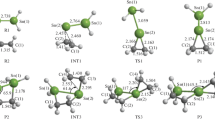Abstract
The H2Ge=Ge: and its derivatives (X2Ge=Ge:, X = H, Me, F, Cl, Br, Ph, Ar……) is a new species. Its cycloaddition reactions is a new area for the study of germylene chemistry. The mechanism of the cycloaddition reaction between singlet Me2Ge=Ge: and acetone has been investigated with the B3LYP/6-31G* method in this article. From the potential energy profile, it can be predicted that the reaction has only one dominant reaction pathway. The reaction rule presented is that the two reactants firstly form a four-membered Ge-heterocyclic ring germylene through the [2 + 2] cycloaddition reaction. Because of the 4p unoccupied orbital of Ge: atom in the four-membered Ge-heterocyclic ring germylene and the π orbital of acetone forming a π → p donor–acceptor bond, the four-membered Ge-heterocyclic ring germylene further combines with acetone to form an intermediate. Because the Ge: atom in the intermediate produces sp3 hybridization after a transition state, then the intermediate isomerizes to a spiro-Ge-heterocyclic ring compound via a transition state. The research result indicated the laws of cycloaddition reaction between Me2Ge=Ge: and acetone, and laid the theory foundation of the cycloaddition reaction between H2Ge=Ge: and its derivatives (X2Ge=Ge:, X = H, Me, F, Cl, Br, Ph, Ar……) and asymmetric π-bonded compounds, which is significant for the synthesis of small-ring and spiro-heterocyclic ring compounds involving Ge. The study extends the research area and enriches the research content of germylene chemistry.







Similar content being viewed by others
References
W.H. Harper, E.A. Ferrall, R.K. Hilliard, S.M. Stogner, R.S. Grev, D.J. Clouthier, J. Am. Chem. Soc. 119, 8361 (1997)
D.A. Hostutler, T.C. Smith, H.Y. Li, D.J. Clouthier, J.Chem.Phys 111, 950 (1999)
D.A. Hostutler, D.J. Clouthier, S.W. Pauls, J. Chem. Phys. 116, 1417 (2002)
S.G. He, B.S. Tackett, D.J. Clouthier, J. Chem. Phys. 121, 257 (2004)
S.M. Stogner, R.S. Grev, J. Chem. Phys. 108, 5458 (1998)
X.H. Lu, Y.H. Xu, H.B. Yu, W.R. Wu, J. Phys. Chem. A 109, 6970 (2005)
X.H. Lu, Y.H. Xu, P.P. Xiang, X. Che, Int. J. Quant. Chem. 108, 75 (2008)
C.L. Tian, Y.H. Xu, X.H. Lu, Int. J. Quant. Chem. 110, 1675 (2010)
X.H. Lu, Y.H. Xu, L.Y. Shi, J.F. Han, Z.X. Lian, J. Organomet. Chem. 694, 4062 (2009)
C. Lee, W. Yang, R.G. Parr, Phys. Rev. B 37, 785 (1988)
K. Fukui, J. Phys. Chem. 74, 4161 (1970)
K. Ishida, K. Morokuma, A. Komornicki, J. Chem. Phys. 66, 2153 (1981)
Author information
Authors and Affiliations
Corresponding author
Rights and permissions
About this article
Cite this article
Lu, X., Li, Y., Liu, D. et al. Density functional theory study of mechanism of forming a spiro-Ge-heterocyclic ring compound from Me2Ge=Ge: and acetone. Res Chem Intermed 41, 235–243 (2015). https://doi.org/10.1007/s11164-013-1186-0
Received:
Accepted:
Published:
Issue Date:
DOI: https://doi.org/10.1007/s11164-013-1186-0




